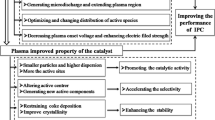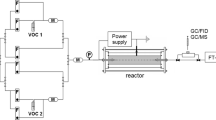Abstract
Non-thermal plasma (NTP) degradation of low-concentration acetone was investigated in a cylindrical dielectric barrier discharge reactor. The effects of oxygen content and flow rate on the removal efficiency at various discharge powers were examined in real-time. The acetone removal efficiency decreases drastically and then remains stable or increases gradually as the O2 content increases from 0 to 25%, and further to 50%. The organic by-products were characterized and quantified using a real-time proton transfer reaction time-of-flight mass spectrometry (PTR-TOF-MS) instrument. The observed organic compounds, with concentrations about ppbv/ppmv by volume, were mainly formaldehyde, methanol, ketene, acetaldehyde, formic acid, acetone, and acetic acid. The discharge power was a critical factor affecting the concentration of the organic by-products and the selectivity toward CO2. The mechanism study based on the by-product monitor in real-time showed that acetone firstly fragments into methyl radicals, acetyl radicals, and H; then, the methyl and acetyl radicals are oxidized by O or OH radicals into acetaldehyde, methanol, and other compounds. It seems that acetaldehyde could be an intermediate in acetone decomposition. Firstly, most of the acetone molecules were decomposed into acetaldehyde molecules; then, the acetaldehyde molecules continued to be decomposed and oxidized into other compounds, such as acetic acid and formaldehyde. These investigations not only proposed a detail decomposition mechanism for acetone in dielectric barrier discharge reactor, but also provided a potential way to analyze and evaluate the practicability of NTP removal of VOCs.








Similar content being viewed by others
References
Al-Abduly A, Christensen P (2015) An in situ and downstream study of non-thermal plasma chemistry in an air fed dielectric barrier discharge (DBD). Plasma Sources Sci Technol 24(6):065006. https://doi.org/10.1088/0963-0252/24/6/065006
Atkinson R (2000) Atmospheric chemistry of VOCs and NOx. Atmos Environ 34(12–14):2063–2101. https://doi.org/10.1016/s1352-2310(99)00460-4
Blin-Simiand N, Jorand F, Magne L, Pasquiers S, Postel C, Vacher JR (2008) Plasma reactivity and plasma-surface interactions during treatment of toluene by a dielectric barrier discharge. Plasma Chem Plasma Process 28(4):429–466. https://doi.org/10.1007/s11090-008-9135-1
Byeon JH, Park JH, Jo YS, Yoon KY, Hwang J (2010) Removal of gaseous toluene and submicron aerosol particles using a dielectric barrier discharge reactor. J Hazard Mater 175(1–3):417–422. https://doi.org/10.1016/j.jhazmat.2009.10.022
Chang C-L, Lin T-S (2005) Decomposition of toluene and acetone in packed dielectric barrier discharge reactors. Plasma Chem Plasma Process 25(3):227–243. https://doi.org/10.1007/s11090-004-3034-x
Choi BS, Yi J (2000) Simulation and optimization on the regenerative thermal oxidation of volatile organic compounds. Chem Eng J 76(2):103–114. https://doi.org/10.1016/S1385-8947(99)00118-7
Dumanoglu Y, Kara M, Altiok H, Odabasi M, Elbir T, Bayram A (2014) Spatial and seasonal variation and source apportionment of volatile organic compounds (VOCs) in a heavily industrialized region. Atmos Environ 98:168–178. https://doi.org/10.1016/j.atmosenv.2014.08.048
Guo H, Cheng HR, Ling ZH, Louie PKK, Ayoko GA (2011) Which emission sources are responsible for the volatile organic compounds in the atmosphere of Pearl River Delta? J Hazard Mater 188(1):116–124. https://doi.org/10.1016/j.jhazmat.2011.01.081
Guo T, Li XS, Li JQ, Peng Z, Xu L, Dong JG, Cheng P, Zhou Z (2018) On-line quantification and human health risk assessment of organic by-products from the removal of toluene in air using non-thermal plasma. Chemosphere 194:139–146. https://doi.org/10.1016/j.chemosphere.2017.11.173
He Q, Yan Y, Li H, Zhang Y, Chen L, Wang Y (2015) Characteristics and reactivity of volatile organic compounds from non-coal emission sources in China. Atmos Environ 115:153–162. https://doi.org/10.1016/j.atmosenv.2015.05.066
Ho SSH, Wang LQ, Chow JC, Watson JG, Xue YG, Huang Y, Qu LL, Li BW, Dai WT, Li L, Cao J (2018) Optimization and evaluation of multi-bed adsorbent tube method in collection of volatile organic compounds. Atmos Res 202:187–195. https://doi.org/10.1016/j.atmosres.2017.11.026
Jiang N, Qiu C, Guo L, Shang K, Lu N, Li J, Wu Y (2017) Post plasma-catalysis of low concentration VOC over alumina-supported silver catalysts in a surface/packed-bed hybrid discharge reactor. Water Air Soil Pollut 228(3):113. https://doi.org/10.1007/s11270-017-3296-6
Karatum O, Deshusses MA (2016) A comparative study of dilute VOCs treatment in a non-thermal plasma reactor. Chem Eng J 294:308–315. https://doi.org/10.1016/j.cej.2016.03.002
Khan FI, Kr. Ghoshal A (2000) Removal of volatile organic compounds from polluted air. J Loss Prev Process Ind 13(6):527–545. https://doi.org/10.1016/S0950-4230(00)00007-3
Kim HH, Ogata A, Futamura S (2016) Oxygen partial pressure-dependent behavior of various catalysts for the total oxidation of VOCs using cycled system of adsorption and oxygen plasma (vol 79, pg 356, 2008). Appl Catal B Environ 185:378–378. https://doi.org/10.1016/j.apcatb.2015.12.048
Kogelschatz U (2003) Dielectric-barrier discharges: their history, discharge physics, and industrial applications. Plasma Chem Plasma Process 23(1):1–46. https://doi.org/10.1023/a:1022470901385
Lee HM, Chang MB (2001) Gas-phase removal of acetaldehyde via packed-bed dielectric barrier discharge reactor. Plasma Chem Plasma Process 21(3):329–343. https://doi.org/10.1023/a:1011018325026
Li JQ, Du XB, Guo T, Peng Z, Xu L, Dong JG, Cheng P, Zhou Z (2017) Study of gas-phase reactions of NO2+ with aromatic compounds using proton transfer reaction time-of-flight mass spectrometry. J Mass Spectrom 52(12):830–836. https://doi.org/10.1002/jms.4027
Machala Z, Marode E, Morvova M, Lukac P (2005) DC glow discharge in atmospheric air as a source for volatile organic compounds abatement. Plasma Process Polym 2(3):152–161. https://doi.org/10.1002/ppap.200400084
Magne L, Blin-Simiand N, Gadonna K, Jeanney P, Jorand F, Pasquiers S, Postel C (2009) OH kinetics in photo-triggered discharges used for VOCs conversion. Eur Phys J-Appl Phys 47(2):9. https://doi.org/10.1051/epjap/2009093
Magureanu M, Mandache NB, Gaigneaux E, Paun C, Parvulescu VI (2006) Toluene oxidation in a plasma-catalytic system. J Appl Phys 99(12):7. https://doi.org/10.1063/1.2204353
Mudliar S, Giri B, Padoley K, Satpute D, Dixit R, Bhatt P, Pandey R, Juwarkar A, Vaidya A (2010) Bioreactors for treatment of VOCs and odours-a review. J Environ Manag 91(5):1039–1054. https://doi.org/10.1016/j.jenvman.2010.01.006
Narengerile, Watanabe T (2012) Acetone decomposition by water plasmas at atmospheric pressure. Cheml Eng Sci 69(1):296–303
Rahimpour MR, Jahanmiri A, Mohamadzadeh Shirazi M, Hooshmand N, Taghvaei H (2013) Combination of non-thermal plasma and heterogeneous catalysis for methane and hexadecane co-cracking: effect of voltage and catalyst configuration. Chem Eng J 219:245–253. https://doi.org/10.1016/j.cej.2013.01.011
Sanjeeva Gandhi M, Mok YS, Lee SB, Park H (2013) Effect of various parameters for butane decomposition under ambient temperature in a dielectric barrier discharge non-thermal plasma reactor. J Taiwan Inst Chem E 44(5):786–794
Schiavon M, Torretta V, Casazza A, Ragazzi M (2017) Non-thermal plasma as an innovative option for the abatement of volatile organic compounds: a review. Water Air Soil Pollut 228(10):20. https://doi.org/10.1007/s11270-017-3574-3
Scirè S, Minicò S, Crisafulli C, Satriano C, Pistone A (2003) Catalytic combustion of volatile organic compounds on gold/cerium oxide catalysts. Appl Catal B Environ 40(1):43–49. https://doi.org/10.1016/S0926-3373(02)00127-3
Shao P, An J, Xin J, Wu F, Wang J, Ji D, Wang Y (2016) Source apportionment of VOCs and the contribution to photochemical ozone formation during summer in the typical industrial area in the Yangtze River Delta, China. Atmos Res 176-177:64–74. https://doi.org/10.1016/j.atmosres.2016.02.015
Trinh HQ, Mok YS (2014) Plasma-catalytic oxidation of acetone in annular porous monolithic ceramic-supported catalysts. Chem Eng J 251:199–206. https://doi.org/10.1016/j.cej.2014.04.071
Van Durme J, Dewulf J, Leys C, Van Langenhove H (2008) Combining non-thermal plasma with heterogeneous catalysis in waste gas treatment: a review. Appl Catal B Environ 78(3–4):324–333. https://doi.org/10.1016/j.apcatb.2007.09.035
Vandenbroucke AM, Morent R, De Geyter N, Leys C (2011) Non-thermal plasmas for non-catalytic and catalytic VOC abatement. J Hazard Mater 195:30–54. https://doi.org/10.1016/j.jhazmat.2011.08.060
Wang SB, Ang HM, Tade MO (2007) Volatile organic compounds in indoor environment and photocatalytic oxidation: state of the art. Environ Int 33(5):694–705. https://doi.org/10.1016/j.envint.2007.02.011
Xu W, Wang N, Chen Y, Chen J, Xu X, Yu L, Chen L, Wu J, Fu M, Zhu A, Ye D (2016) In situ FT-IR study and evaluation of toluene abatement in different plasma catalytic systems over metal oxides loaded γ-Al2O3. Catal Commun 84:61–66. https://doi.org/10.1016/j.catcom.2016.06.004
Yamamoto T (1997) VOC decomposition by nonthermal plasma processing-a new approach. J Electrost 42(1–2):227–238. https://doi.org/10.1016/s0304-3886(97)00144-7
Yuan B, Koss AR, Warneke C, Coggon M, Sekimoto K, de Gouw JA (2017) Proton-transfer-reaction mass spectrometry: applications in atmospheric sciences. Chem Rev 117(21):13187–13229. https://doi.org/10.1021/acs.chemrev.7b00325
Zhang QJ, Wu L, Fang XZ, Liu MY, Zhang J, Shao M, Lu SH, Mao HJ (2018) Emission factors of volatile organic compounds (VOCs) based on the detailed vehicle classification in a tunnel study. Sci Total Environ 624:878–886. https://doi.org/10.1016/j.scitotenv.2017.12.171
Zheng CH, Zhu XB, Gao X, Liu L, Chang QY, Luo ZY, Cen KF (2014) Experimental study of acetone removal by packed-bed dielectric barrier discharge reactor. J Ind Eng Chem 20(5):2761–2768. https://doi.org/10.1016/j.jiec.2013.11.004
Funding
This study received financial support from China Instrumentation Program (No.2017YFF0106000) and National Natural Science Foundation of China (No.41877374)
Author information
Authors and Affiliations
Corresponding author
Additional information
Responsible editor: Bingcai Pan
Publisher’s Note
Springer Nature remains neutral with regard to jurisdictional claims in published maps and institutional affiliations.
Rights and permissions
About this article
Cite this article
Li, X., Guo, T., Peng, Z. et al. Real-time monitoring and quantification of organic by-products and mechanism study of acetone decomposition in a dielectric barrier discharge reactor. Environ Sci Pollut Res 26, 6773–6781 (2019). https://doi.org/10.1007/s11356-019-04127-z
Received:
Accepted:
Published:
Issue Date:
DOI: https://doi.org/10.1007/s11356-019-04127-z




